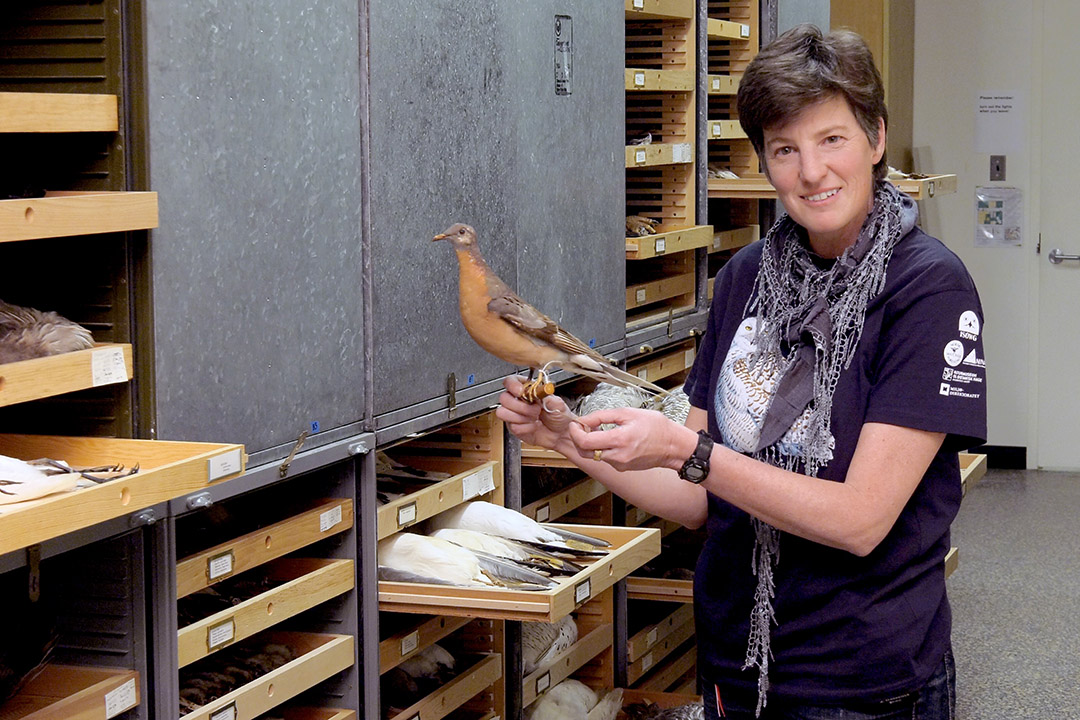
Bird collection a feather in the cap for USask ornithologist
A stuffed specimen of a now-extinct passenger pigeon dating back to 1875 is one of the highlights of the bird collection amassed over more than a century at the University of Saskatchewan (USask).
By Shannon Boklaschuk“There are estimated to be 1,500 stuffed passenger pigeon specimens at institutions around the world, but I’m not sure how many other Canadian universities have specimens—certainly not very many. We are lucky to have one,” said ornithologist Dr. Karen Wiebe (PhD), a faculty member in the Department of Biology in USask’s College of Arts and Science.
“Passenger pigeons were once the most numerous bird species in North America and their story of being hunted to extinction is very tragic,” she said.
The passenger pigeon is one of the oldest and rarest stuffed bird specimens at USask. It is one of about 2,500 birds currently found in the university’s vertebrate collection, which also includes about 3,000 specimens of mammal skulls and stuffed mammals. Stored in the teaching wing of the W.P. Thompson Biology Building, the bird collection is highlighted in a new video on the website of the Museum of Natural Sciences.
The bird collection was started in 1917, near the founding of USask, when early biology professors began accumulating deceased birds. Since then, it has been gradually growing for more than a century, as students and faculty members continue to add more samples. Wiebe, who holds the Stuart and Mary Houston Professorship in Ornithology, has curated the collection since she was hired at USask in 1997.
The collection is mainly used by faculty members and graduate students studying the morphology and evolutionary ecology of vertebrates. For example, tissue samples from the toenails or feathers of the stuffed birds have been used to obtain stable isotope profiles, which are useful for determining the birds’ diets and geographical origins.
“I am currently using DNA samples from snowy owl feathers for phylogenetic analyses and to determine genetic similarity between populations and subspecies. Bird specimens in the collection have also been used to study fault bars in feathers and variation in plumage colour, which can be signals of individual quality or environmental stressors,” said Wiebe.
“On the teaching side, the study skins and/or skulls of birds and mammals are used in the labs for upper-level biology courses to teach about morphological variation, adaptations and evolution of vertebrates. The biology labs are so much more vivid and engaging with real specimens to show students and not just photographs or videos.”
As an ornithologist, Wiebe studies the behaviour, reproduction and ecology of birds. Much of her work focuses on factors that determine the reproductive success of individuals, such as predation risk, food supply, and habitat and nest site selection. She is especially interested in incubation and hatching patterns, and sex roles during reproduction.
While it is difficult for Wiebe to choose a favourite species, she is particularly fond of the northern flicker—a bird she has studied for two decades.
“The flicker is a colourful woodpecker and a great example of hybridization of subspecies which exist in different plumage colours—a process called introgression,” she said. “I’ve added several unusual hybrid flicker specimens from my field site in British Columbia to the department’s collection over the years. I’ve especially tried to add species from British Columbia that were missing from the collection, birds like Steller’s jay, barn owls, varied thrush—things that I find as road kills or window strikes out here.”
In the summer, Wiebe travels to B.C. to conduct fieldwork. Until the wildfires of 2017 burned down her long-term study site at Riske Creek, B.C., her primary focus was on the behaviour and ecology of northern flickers—a 20-year study of a colour-banded population.
“I’m now doing fieldwork on other cavity-nesting birds—mainly mountain bluebirds and tree swallows—which use the approximately 250 nest boxes I’ve put up in the area. My main research questions include the effects of habitat alteration—clearcutting—on prey availability and reproductive success. I’m also studying competition for nest sites among species of cavity-nesting birds,” she said.
“In the winter, when I’m in Saskatchewan, I study snowy owls by tracking their movements with satellite transmitters.”
More videos featuring Wiebe’s research can be found on the Museum of Natural Sciences website.

